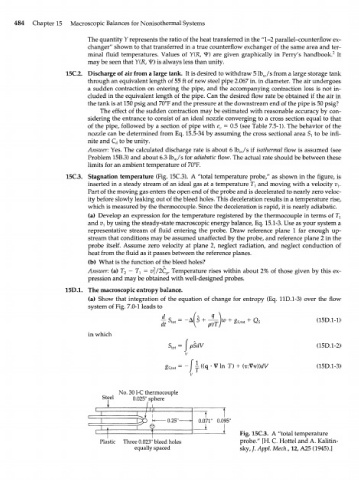Page 504 - Bird R.B. Transport phenomena
P. 504
484 Chapter 15 Macroscopic Balances for Nonisothermal Systems
The quantity У represents the ratio of the heat transferred in the "1-2 parallel-counterflow ex-
changer" shown to that transferred in a true counterflow exchanger of the same area and ter-
minal fluid temperatures. Values of Y(R, 4?) are given graphically in Perry's handbook. 2 It
may be seen that Y(R, 40 is always less than unity.
15C.2. Discharge of air from a large tank. It is desired to withdraw 5 lb /s from a large storage tank
m
through an equivalent length of 55 ft of new steel pipe 2.067 in. in diameter. The air undergoes
a sudden contraction on entering the pipe, and the accompanying contraction loss is not in-
cluded in the equivalent length of the pipe. Can the desired flow rate be obtained if the air in
the tank is at 150 psig and 70°F and the pressure at the downstream end of the pipe is 50 psig?
The effect of the sudden contraction may be estimated with reasonable accuracy by con-
sidering the entrance to consist of an ideal nozzle converging to a cross section equal to that
of the pipe, followed by a section of pipe with e v = 0.5 (see Table 7.5-1). The behavior of the
nozzle can be determined from Eq. 15.5-34 by assuming the cross sectional area S^ to be infi-
nite and Q to be unity.
Answer: Yes. The calculated discharge rate is about 6 lb /s if isothermal flow is assumed (see
m
Problem 15B.3) and about 6.3 lb /s for adiabatic flow. The actual rate should be between these
m
limits for an ambient temperature of 70°F.
15C.3. Stagnation temperature (Fig. 15C.3). A "total temperature probe," as shown in the figure, is
inserted in a steady stream of an ideal gas at a temperature 7^ and moving with a velocity v v
Part of the moving gas enters the open end of the probe and is decelerated to nearly zero veloc-
ity before slowly leaking out of the bleed holes. This deceleration results in a temperature rise,
which is measured by the thermocouple. Since the deceleration is rapid, it is nearly adiabatic.
(a) Develop an expression for the temperature registered by the thermocouple in terms of Т л
and Vi by using the steady-state macroscopic energy balance, Eq. 15.1-3. Use as your system a
representative stream of fluid entering the probe. Draw reference plane 1 far enough up-
stream that conditions may be assumed unaffected by the probe, and reference plane 2 in the
probe itself. Assume zero velocity at plane 2, neglect radiation, and neglect conduction of
heat from the fluid as it passes between the reference planes.
(b) What is the function of the bleed holes?
Answer: (a) T 2 - T } = v\/2C r Temperature rises within about 2% of those given by this ex-
pression and may be obtained with well-designed probes.
15D.1. The macroscopic entropy balance.
(a) Show that integration of the equation of change for entropy (Eq. 11D.1-3) over the flow
system of Fig. 7.0-1 leads to
, Я
+ gstoi + Qs (15D.1-1)
in which
> = j pSdV (15D.1-2)
tot
T) + (T:VV)WV (15D.1-3)
No. 30 I-C thermocouple
Steel 0.025" sphere
I /
F ~T I
-0.25"- 0.071" 0.095"
_L
Fig. 15C.3. A "total temperature
Plastic Three 0.023" bleed holes probe." [H. C. Hottel and A. Kalitin-
equally spaced sky, /. Appl. Mech., 12, A25 (1945).]

